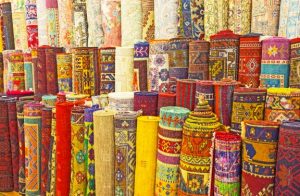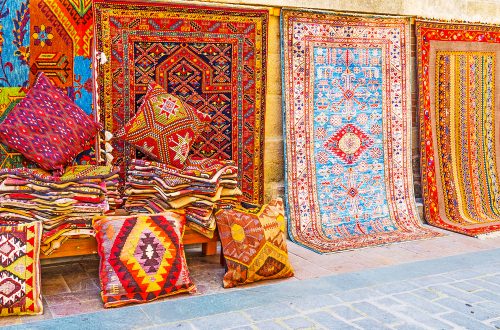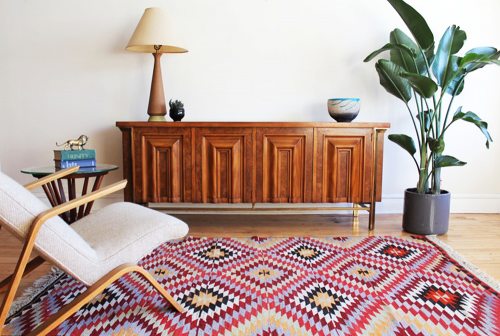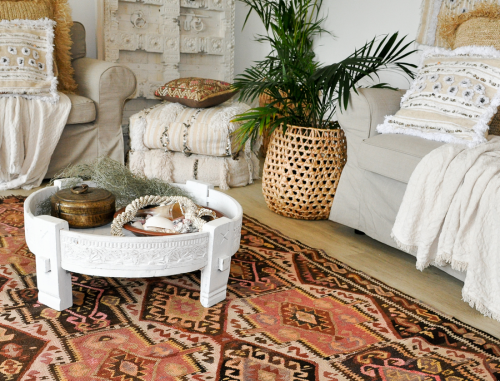Kilim Rugs: a Luxurious Decor Option

In our post today, we’d like to give you information on Kilim rugs: what they are exactly, where you can find them, which styles to use them with, etc.
Rugs are the most popular decor piece in interior design. As we’ve already talked about in our previous posts, we can find them in all kinds of shapes, sizes, materials, and designs. There are also certain kinds of rugs for walls, like a tapestry.
Many people opt to use Oriental rugs for their decor. They can create an ethnic feel for your home. To create a perfect hint of exoticism, you really need to know how to use a room’s accessories and furniture together to create a natural, harmonious set.
You need to play around with colors and texture. For example, you can try to decorate with a minimalist ethnic decor, but you need to be careful with the decor balance and not overwhelm the setting.
A great example piece to use is a Kilim rug, which is the topic of our post today. Kilim rugs originated in the nomadic towns of Central Asia more than 3,500 years ago. They’re made with natural materials such as wool, cotton or silk. These materials translate are high quality and have a long life.

What are Kilim rugs like?
First things first, we’d like to inform our readers that a rug and Kilim aren’t actually the same thing. How they’re made is very different:
- To make a rug, different knots are tied together in the weave (both horizontally and vertically).
- Kilims, however, are made only by alternating the horizontal sections with the vertical sections of the weaves. The name “Kilim” actually refers to this textile technique.
These are artisan rugs that are handwoven, which increases their value. As for their patterns, you can often find geometric motifs, such as triangles or rhombuses. They might be inverted. Some Kilims use a trim around its entire perimeter.
These rugs are very colorful. However, if you look carefully, you’ll notice that the colors (that are derived from natural products) are never mixed together.
Which decor styles go well with Kilim rugs?
Not surprisingly, they look great in a home that has ethnic decor, such as Arab or Asian style. If you’re a frequent traveler, you might be interested to know that many people buy Kilims when traveling through Arab countries. So, finding other decor pieces (pillows, containers, etc.) with the same style would create a balance.

Another idea is using Kilim rugs to decorate in a Nordic style. Just think about it: plenty of light, light colors, natural materials and fibers, exposed wood. A Kilim rug could add an original touch. You’d just have to be careful not to mix patterns. If you’re a fan of “less is more”, we suggest looking through the possibilities of mixing the minimalist and Nordic styles.
You might also want to think about using a Kilim in a Bohemian layout. They’re usually colorful, happy atmospheres. You could use poofs or floor cushions on top of the rug. If you add a low table nearby, you could enjoy the perfect nook.
If you mix and match your furniture and accessories carefully enough, you could also use a Kilim rug with an industrial style decor, too. Many lofts use a big Kilim rug in the bedroom or living room area.
Going a step further, you can also use these rugs to decorate your walls like a tapestry. They go best with white walls or walls of a lighter color.
Where can you buy them?
You can find them by traveling to their originating countries. If not, you can always look in an antique store. And there are other stores that sell them as well.

To give you an example, you can find them at IKEA. In IKEA’s Oriental rug selection, you can browse through some lovely options. The biggest rugs can cost around 300 to 400 euros.
Maisons du Monde is another idea. Here you can find multicolored wool rugs with geometric patterns. There are also other furniture pieces with the same pattern, which would add originality to any room. For example, they offer two chairs and an armchair in a geometric pattern. They would look marvelous in spaces with ethnic decor.
With Kilim rugs, you can bring some color and life into your rooms. They’re very versatile as well: remember that you can use them both for your floors or your walls.
In our post today, we’d like to give you information on Kilim rugs: what they are exactly, where you can find them, which styles to use them with, etc.
Rugs are the most popular decor piece in interior design. As we’ve already talked about in our previous posts, we can find them in all kinds of shapes, sizes, materials, and designs. There are also certain kinds of rugs for walls, like a tapestry.
Many people opt to use Oriental rugs for their decor. They can create an ethnic feel for your home. To create a perfect hint of exoticism, you really need to know how to use a room’s accessories and furniture together to create a natural, harmonious set.
You need to play around with colors and texture. For example, you can try to decorate with a minimalist ethnic decor, but you need to be careful with the decor balance and not overwhelm the setting.
A great example piece to use is a Kilim rug, which is the topic of our post today. Kilim rugs originated in the nomadic towns of Central Asia more than 3,500 years ago. They’re made with natural materials such as wool, cotton or silk. These materials translate are high quality and have a long life.

What are Kilim rugs like?
First things first, we’d like to inform our readers that a rug and Kilim aren’t actually the same thing. How they’re made is very different:
- To make a rug, different knots are tied together in the weave (both horizontally and vertically).
- Kilims, however, are made only by alternating the horizontal sections with the vertical sections of the weaves. The name “Kilim” actually refers to this textile technique.
These are artisan rugs that are handwoven, which increases their value. As for their patterns, you can often find geometric motifs, such as triangles or rhombuses. They might be inverted. Some Kilims use a trim around its entire perimeter.
These rugs are very colorful. However, if you look carefully, you’ll notice that the colors (that are derived from natural products) are never mixed together.
Which decor styles go well with Kilim rugs?
Not surprisingly, they look great in a home that has ethnic decor, such as Arab or Asian style. If you’re a frequent traveler, you might be interested to know that many people buy Kilims when traveling through Arab countries. So, finding other decor pieces (pillows, containers, etc.) with the same style would create a balance.

Another idea is using Kilim rugs to decorate in a Nordic style. Just think about it: plenty of light, light colors, natural materials and fibers, exposed wood. A Kilim rug could add an original touch. You’d just have to be careful not to mix patterns. If you’re a fan of “less is more”, we suggest looking through the possibilities of mixing the minimalist and Nordic styles.
You might also want to think about using a Kilim in a Bohemian layout. They’re usually colorful, happy atmospheres. You could use poofs or floor cushions on top of the rug. If you add a low table nearby, you could enjoy the perfect nook.
If you mix and match your furniture and accessories carefully enough, you could also use a Kilim rug with an industrial style decor, too. Many lofts use a big Kilim rug in the bedroom or living room area.
Going a step further, you can also use these rugs to decorate your walls like a tapestry. They go best with white walls or walls of a lighter color.
Where can you buy them?
You can find them by traveling to their originating countries. If not, you can always look in an antique store. And there are other stores that sell them as well.

To give you an example, you can find them at IKEA. In IKEA’s Oriental rug selection, you can browse through some lovely options. The biggest rugs can cost around 300 to 400 euros.
Maisons du Monde is another idea. Here you can find multicolored wool rugs with geometric patterns. There are also other furniture pieces with the same pattern, which would add originality to any room. For example, they offer two chairs and an armchair in a geometric pattern. They would look marvelous in spaces with ethnic decor.
With Kilim rugs, you can bring some color and life into your rooms. They’re very versatile as well: remember that you can use them both for your floors or your walls.







